MAJOR FINDINGS—Continued
Pesticides, PCBs, other organics, and trace elements have accumulated in bottom sediment and fish
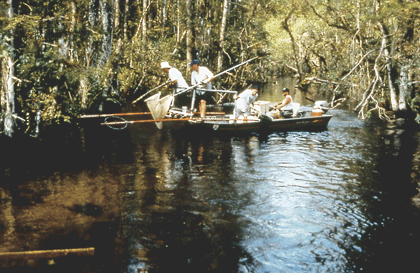 |
| Fish sampling in Big Cypress Swamp as part of the southern Florida NAWQA study. |
Many pesticides, other trace organic compounds, and trace elements are hydrophobic; that is, in aquatic environments they tend to be associated with sediment particles and biological tissues rather than dissolved in water. For this reason, sampling bottom sediment and fish is an effective way to assess the occurrence of these contaminants in the aquatic environment.
The most frequently detected pesticides in bottom sediment at the SOFL sites during 1996–98 were DDT and its breakdown products DDE and DDD, ranging from 2.4 to 670 micrograms per kilogram (µg/kg). DDE exceeded the Canadian sediment quality guidelines probable effects level (PEL) of 6.75 µg/kg (Environment Canada, 1999) at four of the seven fixed sites, including the Hillsboro Canal at S-6 (308 µg/kg) and the Kissimmee River at S-65E (670 µg/kg). More than 40 organic compounds were detected in bedsediment from the Hillsboro Canal at S-6, including ametryn, chlordane, DDT compounds, dieldrin, endosulfan, and other semivolatile organic compounds, including polycyclic aromatic hydrocarbons (PAHs).
The most frequently detected pesticides in fish at 15 SOFL sites also were DDT and its breakdown products. Largemouth bass and (or) Florida gar were collected at each site, and one or more samples (5–8 whole fish) were analyzed for pesticides. DDT compounds were detected in 25 of the 27 composited fish samples. Concentrations of total DDT ranged from less than 5 to 1,170 µg/kg in Florida gar and from less than 5 to 610 µg/kg in largemouth bass. The most commonly detected and abundant DDT product was p,p'-DDE. Total DDT concentrations exceeded the 200-µg/kg guidelines (Newell and others, 1987) for the protection of fish-eating wildlife in 4 of 27 fish samples. Highest concentrations of total DDT were in canals of the northern Everglades near agricultural lands. For comparison, during 1970–73 concentrations of total DDT in 49 composite fish samples from 12 sites in southern Florida ranged from 6 to 800 µg/kg. In 1978, total DDT concentrations in 23 fish samples ranged from 3 to 1,650 µg/kg (Haag and McPherson, 1997).
Other organochlorine compounds and PCBs detected in the composite whole-fish samples collected during 1995–96 include polychlorinated biphenyls (PCBs) and the pesticides dieldrin, mirex, and various compounds of chlordane (cis-chlordane, oxy-chlordane, trans-chlordane, trans-nonachlor, and cis-nonachlor). Maximum concentrations of pesticides occurred primarily in fish collected in Hillsboro Canal at S-6. PCBs were detected in three separate fish samples; the maximum concentration (140 µg/kg) was in fish collected from Black Creek Canal. Dieldrin and toxaphene were two other pesticides commonly detected in composite fish samples from the Everglades in the early 1970s. Concentrations of dieldrin in largemouth bass were as high as 130 µg/kg, and concentrations of toxaphene were as high as 5,000 µg/kg. In 1995, dieldrin concentrations ranged from less than 5 to 18 µg/kg, and 5 of 27 fish samples had detectable dieldrin. Toxaphene was not detected in fish collected during 1995–96, but the analytical method was not very sensitive for toxaphene (only levels greater than 200 µg/kg could be detected).
The types and amounts of pesticides used in Florida have changed over the years because of new technology, land use, and State and Federal regulations. One of the most frequently detected herbicides in bed sediment in southern Florida, ametryn, is used in relatively small amounts on sugarcane crops (6 tons per year [tons/y]) (Miles and Pfeuffer, 1997). By far, the greatest frequency of insecticide detection was the organochlorine insecticides, such as DDD, DDE, DDT, dieldrin, and heptachlor. DDT was banned for most uses in the Nation in 1973. These insecticides also are the most frequently detected pesticides in bottom sediments (Shahane, 1994). Although most organochlorine pesticides such as DDT and chlordane are no longer sold in the United States, they persist in the environment and continue to pose potential threats to wildlife and humans. Persistent organochlorine pesticides were detected beginning in the late 1960s and early 1970s (Kolipinski and Higer, 1969; McPherson, 1973) in bottom sediment and fish that are a part of the food chain in the Everglades. Reflooding of farm lands for Everglades restoration potentially could lead to mobilization of persistent organochlorine pesticides and foodweb contamination, as occurred in Lake Apoka just north of the study area. Many organo-chlorine pesticides and PCBs also have been linked to hormone disruption and reproductive problems in aquatic animals (Colborn and others, 1993).
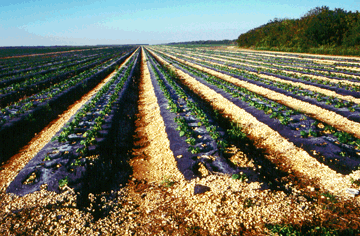 |
|
| Row crops, C-111 basin, southern Florida. |
Polynuclear aromatic hydrocarbons (PAHs) are contaminants in soils and sediments and originate from such sources as crude oil and tar and from forest fires and incomplete combustion of fossil fuels. Bottom-sediment samples were collected at 10 sites in a survey of the Barron River Canal in 1998 to evaluate the occurrence of PAHs and other semivolatile organic compounds in the vicinity of the Big Cypress National Preserve (Miller and McPherson, U.S. Geological Survey, in press). PAHs normalized to organic carbon had patterns of distribution that indicated sources to be roads, vehicles, or an old creosote wood-treatment facility. Concentrations of phthalate esters and the trace elements arsenic, cadmium, and zinc in the Barron River Canal appear to have a nonpoint source and to be influenced by local bed-sediment properties, such as sediment particle size and organic content. At some Barron River Canal sites, lead, copper, and zinc, normalized to aluminum, exceeded background levels and may be enriched by human activities. Trace elements in bottom-sediment samples from the Barron River Canal sites did not exceed the Canadian PEL for freshwater sediment.
Mercury is a contaminant in the Southern Florida Study Unit
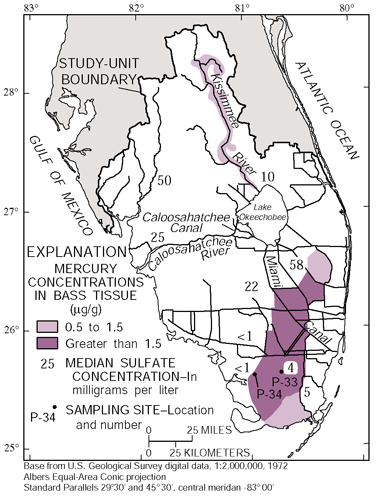 |
| Figure 11. Mercury concentrations in large-mouth bass tissue equaled or exceeded 0.5 µg/g in an area in southern Florida. (Lambou and others, 1991). Median sulfate concentrations at SOFL sites, P-33 and P-34, in mg/L, 1996-98 (P-site data from South Florida Water Management District). |
Game fish in the Everglades have concentrations of mercury that exceed recommended levels (1.5 micrograms per gram, µg/g) for human consumption (Ware and others, 1990; fig. 11). The maximum concentrations of mercury found in edible portions of largemouth bass (4.4 µg/g) collected from the Everglades exceeded mercury concentrations in game fish from all other parts of the State (Stober and others, 1995). The NAWQA Program specifies that trace elements (including mercury) be determined for fish livers. Thus, the data are not directly comparable to data from studies analyzing fish fillets (the edible portion of the fish). Mercury concentrations in composite samples of largemouth bass livers from the SOFL sites ranged from 0.4 µg/g in Black Creek Canal to 42 µg/g in Miami Canal at S-8. Mercury concentrations in Florida gar livers ranged from 2.1 µg/g in the Caloosahatchee River at Alva to 190 µg/g in the Miami Canal at S-8. Largemouth bass and gar are top predators; on average, mercury concentrations in gar livers were about four times higher than mercury concentrations in largemouth bass livers.
The high concentrations of mercury in fish result from food-web bioaccumulation of methyl-mercury, the most biologically available form of mercury in the environment (fig. 12). Buildup in the Everglades food web begins with high rates of bacterial mercury methylation at the sediment-water interface and subsequent transport of methylmercury from this interface into the water column. The Everglades region had one of the highest methylmercury to mercury ratios in sediment of the 21 NAWQA basins sampled in 1998 (Krabbenhoft and others, 1999a).
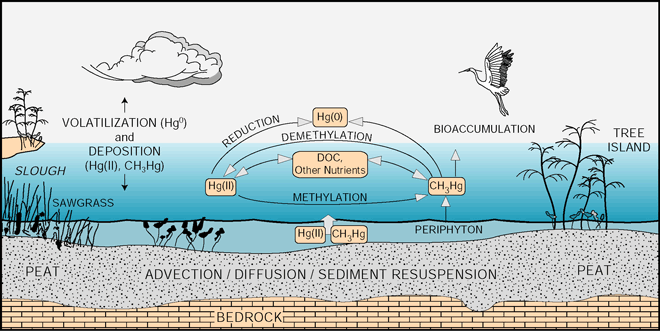 |
| Figure 12. High concentrations of mercury in Everglades fish, birds, and other organisms is a result of food web bioaccumulation of methylmercury, which originates primarily at the sediment and periphyton-water interface (modified from Krabbenhoft, 1996). |
Mercury methylation rates in the Everglades are affected by complex physical-chemical-biological processes that vary widely from day to night, from season to season, and along spatial gradients. Two of the most important controls on mercury methylation are availability of sulfur and bacterial cycling of sulfur. Sulfur inputs to the Everglades have increased over background levels during the 20th century as a result of runoff containing agricultural fertilizers. Large inputs of sulfur in parts of the northern Everglades have stimulated sulfate reduction that would normally favor methylation, but very high levels of sulfide in the eutrophic areas have an inhibitory effect on methylation rates. Lower levels of sulfur contamination in the central Everglades (fig. 11) have increased sulfate reduction and mercury methylation without the inhibitory effects of excess sulfide on methylation rates (Benoit and others, 1999; Orem and others, 1999, p. 79). Concentrations of mercury are higher in fish and other organisms in the more remote and low-nutrient waters of the central and southern Everglades than in the high-nutrient waters of the northern Everglades (Cleckner and others, 1998; Gilmour and others, 1998; Hurley and others, 1998).
Degradation of methylmercury also is a dynamic process that varies from day to night and spatially across the Everglades. Microbial demethylation rates in the sediments do not show strong spatial patterns, whereas photo-demethylation rates in the water column do show a strong north to south upward trend, ranging from 2 to 15 percent per day, as a result of decreasing DOM in the water column from north to south and the resulting increase in light penetration in the south (Krabbenhoft and others, 1999b).
Atmospheric sources supply mercury that sustains methylation and food-web biomagnification in the Everglades. The southern Florida area has one of the highest atmospheric mercury deposition rates (25 micrograms per square meter per year, µg/m²/y) in the United States (Krabbenhoft and others, 1999a). Atmospheric inputs have local sources, such as medical, municipal, and industrial incinerators, landfills, power plants, and other urban activities, and global sources. Local sources are considered by most investigators to be primarily responsible for the relatively high atmospheric mercury inputs in southern Florida.
Biological communities are influenced by water quality
The distribution of fish, invertebrates, and algae within a river or canal is influenced by natural conditions and human activities that affect water quality and available habitat. Generally, a diverse aquatic community composed of a variety of species and dominated by no single species or group of species is an indicator of favorable biotic conditions and an absence of contaminants and other environmental stresses. Although human activities have caused significant changes in many southern Florida freshwater habitats, it is important to understand how unique natural conditions in southern Florida influence the composition of aquatic communities there.
Sixty-three species of fish in 26 families were collected in the seven canals and rivers sampled in the SOFL Study Unit during 1996–98. The fish community included 43 native species and 10 exotic or non-native species. Additionally, 10 species of marine fish that periodically inhabit portions of canals and rivers in southern Florida also were collected. The chemical composition of freshwater in southern Florida, in particular the concentrations of sodium, chloride, and calcium, facilitates the invasion and occasional establishment of fishes with broad salinity tolerance (Loftus and Kushlan, 1987). No fish species listed as threatened or endangered in the United States or Florida were collected in southern Florida during the NAWQA study.
Florida rivers have smaller drainage basins and fewer fish species than rivers in the adjacent Southeastern United States (Swift and others, 1986). Natural conditions, in this case the repeated rise and fall of sea level over geologic time, have reduced the number of freshwater fish species in the Florida peninsula. The present fish community represents the most recent reinvasion following sea-level withdrawal (Bass, 1990). The most important natural factors limiting the diversity of the fish community are unsuitability of habitat and climate for temperate species (Loftus and Kushlan, 1987).
The rivers in southern Florida have very low gradients, typically only a few inches per mile (McPherson and Halley, 1996), as well as slow current velocities, high water temperatures, and low dissolved-oxygen concentrations. Fish and invertebrate communities are characterized by species that prefer these conditions and by the absence of related species that are found only in cool, swiftly flowing, well-oxygenated streams. The number of fish species collected at SOFL sites, or the species richness of the community, tended to increase with increasing mean annual dissolved-oxygen concentrations. Some game-fish species, such as bass, were absent at sites with the lowest dissolved-oxygen concentrations. One entire group of invertebrates (Plecoptera: stoneflies), which prefer cool running waters, usually are not found anywhere in the waters of southern Florida. Diptera (true flies) was the dominant insect group at all sites (fig. 13). Many of the Diptera were species in the family Chironomidae (midges), which are adapted to aquatic environments with sandy substrates and very low dissolved-oxygen concentrations, such as those prevalent in southern Florida surface waters. Species in this family are also tolerant of nutrient enrichment and contaminants.
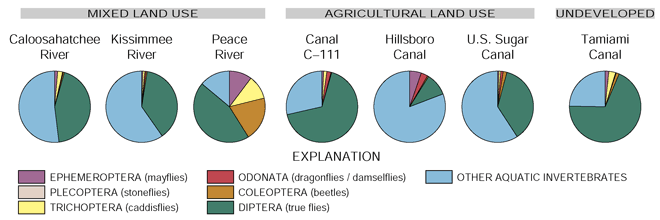 |
| Figure 13. Diptera (true flies) dominated the insect community at the Southern Florida National Water-Quality Assessment Study Unit Sites, 1996–98. |
In the canals and some of the rivers of southern Florida, habitat alteration is significant. The canal channels are rectangular in cross-section, and they have been channelized and are routinely dredged to facilitate navigation and the movement of water. There are few areas of shallow water (littoral zone) to provide sufficient light for attached algae (periphyton) and suitable spawning areas for fish. Moreover, aquatic vegetation is periodically removed for water-management purposes, further reducing habitat for small fish and invertebrates that serve as food for fish. The species richness of fish and the total numbers of fish collected generally were lowest in the canals of southern Florida in basins with agricultural land use (fig. 14). The canals and channelized rivers have little suitable habitat of any kind for many aquatic insects that prefer hard substrate, such as caddisflies (Trichoptera) and some mayflies (Ephemeroptera); snags (woody debris) are scarce because bankside vegetation is usually cleared, and hard surfaces, such as rock, are limited to porous limestone outcroppings.
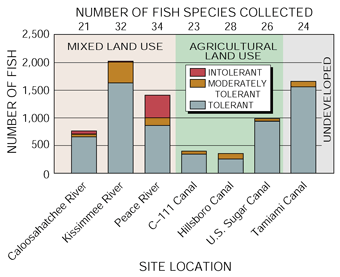 |
| Figure 14. Environmentally tolerant fish are common in southern Florida canals and rivers. |
Fish can be categorized on the basis of their ability to tolerate a range of environmental conditions. There were no intolerant fish species collected in any of the canals in southern Florida (fig. 14). The presence of intolerant species in the Peace River during the SOFL study, as well as in earlier studies (Champeau, 1990), indicates favorable biotic conditions. The Peace River is unique among the rivers sampled in southern Florida because it has not been channelized, and the main channel is connected to the flood plain during periods of high water. The flood plain provides a refuge for fish during high flow, perhaps enhancing survival and reproduction. Also, periodic flooding results in input of particulate organic matter and dissolved organic carbon from the flood plain, which increases the productivity of the river and increases its ability to support a diverse fish community.
The environmental conditions in the Peace River also supported a diverse aquatic insect community compared to most other SOFL sites (fig. 13). For example, the Peace River had the highest mean dissolved-oxygen concentration of any southern Florida site. Hard substrates, such as the woody snags preferred by many aquatic insects, were abundant. Seasonal input of leaf debris (particulate organic matter) from the flood plain provides a valuable food source for many aquatic invertebrates. In contrast, Hillsboro Canal, a relatively degraded SOFL site, had insects from a number of different groups, but few of the pollution-sensitive insects, including caddisflies, were present.
In many parts of the United States, the abundance of a group of invertebrate taxa referred to as the EPT taxa (Ephemeroptera, Plecoptera, Trichoptera) is used to assess the biotic condition of streams and rivers. Species in these insect groups generally thrive in conditions of flowing water, moderate to high dissolved oxygen, and low suspended sediment and are intolerant of contaminants and habitat disturbance. The relative abundance of EPT taxa compared to the more tolerant Diptera taxa can be used to assess and compare sites. However, this metric must be used with caution because Plecoptera usually are not found in southern Florida. The Peace River had the highest EPT/Diptera ratio compared to the other SOFL sites. The Peace River also supported a diverse algae community with the greatest species richness (220 species) of all the SOFL sites. Total phosphorus and nitrogen concentrations were high in the Peace River compared to other SOFL sites because of natural conditions and human activities. The availability of these essential nutrients, combined with an unmodified habitat and more shallow-water areas, may contribute to a more diverse algal community.
The Tamiami Canal is unique among the SOFL canal sites because land within its basin is mostly undeveloped, limiting the input of contaminants. However, the environmental conditions are stressful because the shallow canal has almost no flow, the water is warm, and dissolved-oxygen concentrations typically are very low. Nutrient concentrations were among the lowest of the SOFL sites. The insect community was dominated by Diptera, although some Trichoptera that are adapted to still or slow-flowing conditions were collected. Bluegreen algae were relatively abundant. The fish community showed little similarity to any of the other sites and was characterized by an abundance of minnows and Florida gar. The Tamiami Canal had the smallest proportion (5 percent) of fish with external anomalies. External anomalies, such as eroded fins, lesions, ulcers, tumors, and external parasites, can be an indication that fish are stressed by environmental conditions or contaminants. The highest percentages of fish with external anomalies were from the Hillsboro (32 percent) and C-111 Canals (22 percent). Anomalies at these two sites were primarily external parasites, eroded fins, and anatomical deformities. These two sites were in the top 25 percent of 144 NAWQA sites sampled nationwide.
|
Algae Siltation Index
Algae collected at the seven southern Florida NAWQA sites were compared to algae at 140 national NAWQA sites by using the Siltation Index (Bahls and others, 1992). This index is the relative abundance of the motile diatoms Navicula, Nitzschia, Cylindrotheca, and Surirella in a diatom count. These diatoms are able to move through silt particles, and because they are able to avoid being buried, they are considered more tolerant of sedimentation than other diatoms. The values for this index are higher for streams in agricultural basins. Based on the relative abundance of these diatoms, the undeveloped Southern Florida site (Tamiami Trail Canal) falls into the less degraded stream category, whereas the agricultural sites are between the 25th and 50th percentile, and two of the three major river sites in the mixed land-use category are near or above the 75th percentile. See pages 18–20 for how algae communities compare at sites within the SOFL Study Unit. Invertebrate Community Status Index (ICSI)
Invertebrate communities at the seven southern Florida NAWQA sites were compared to invertebrate communities at NAWQA sites nationwide by using a multimetric index. The index combines 11 metrics, including ones that assess taxa richness and diversity, taxa richness of mayflies, stoneflies, and caddisflies, and various measures of environmental tolerance. Using the ICSI, all seven of the Southern Florida sites ranked above the 75th percentile, indicating that they are among the most degraded sites in the Nation. Use of the ICSI in southern Florida must be approached with caution because background environmental conditions prevalent at all sites, including slow water velocities and low dissolved-oxygen concentrations, probably contribute to the high index values and may obscure differences in invertebrate communities because of other factors, such as land use or changes in habitat. The dominance of Diptera (true flies), insects that are tolerant of degraded environmental conditions, and low diversity of insects overall contribute to the high ICSI scores for Southern Florida. See pages 18–20 for how insect communities compare at sites within the SOFL Study Unit. Fish Status Index
To facilitate comparisons, fish collected at NAWQA sites across the Nation were classified based on four fish metrics (percentage of tolerant, ominvorous, non-native individuals, and percentage of individuals with external anomalies). Nationwide, higher values suggest a more degraded stream site. Six of the SOFL sites, including the reference site, ranked in the highest 25th percentile cataegory for the Nation. Environmental conditions mentioned above for invertebrates also may contribute to stress in the fish community at sites including the reference site. This environmental stress can lead to dominance of tolerant fish, favorable conditions for exotic species, and increased external anomalies at some sites in the SOFL Study Unit, leading to higher values compared with other sites nationwide. See pages 18–20 for a discussion of how fish communities compare at sites within the SOFL Study Unit. |
Exotic species are a threat to native biota
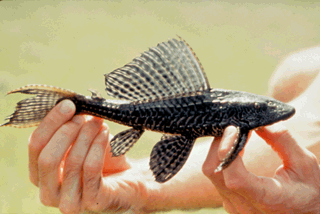 |
| The exotic sailfin catfish, Pterygoplichthys disjunctivus, is a South American invader. |
Exotic or non-native species of fish, as well as other animals and plants, represent a major threat to native biota in southern Florida. Exotic fish compete with native species for food and habitat. Exotic plants crowd out native species and can form dense monocultures that alter habitat for birds, fish, and other native biota. Ten exotic fish species were collected at the SOFL sites during 1996–98 (fig. 15). Cichlids were the most numerous and widespread exotic species, including the black acara, Mayan cichlid, peacock cichlid, blue tilapia, spotted tilapia, and the oscar. The other exotic species collected (pike killifish, grass carp, walking catfish, and sailfin catfish) were all rare and found at only one or two sites each. Fifty-four exotic fish species have been recorded in southern Florida, and the total statewide exceeded 125 species by 1998 (Fuller and others, 1999). Nearly all the exotic fish species were originally imported for the aquarium trade and either escaped from fish farms or were released by individuals with home aquariums. Exotic fish usually are most abundant in streams that have been altered by human activity (Moyle, 1986). Generally, the canal sites in southern Florida had more exotic species than the major rivers. The number of species of exotic fish at SOFL sites ranked in the top one-third of NAWQA sites nationwide.
The swamp eel (Monopterus albus), recently introduced from Southeast Asia, is a potentially dangerous invader. The swamp eel can breathe air for extended periods of time, enabling it to inhabit stagnant water and even live out of water. This characteristic also enhances its ability to disperse widely. It is a voracious general predator, making it a threat to native fishes, amphibians, and aquatic invertebrates. The swamp eel was not collected at any of the SOFL sites during 1996–98. However, this species has affected regional water-management practices. Selected water-control structures in the vicinity of established populations are not being opened to prevent or at least retard dispersal, particularly into waters of ENP.
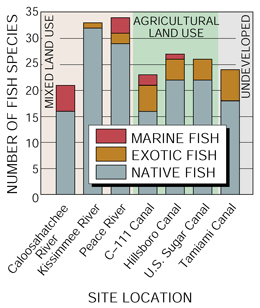 |
| Figure 15. Exotic fish species were collected at all SOFL sites, 1996-98. |
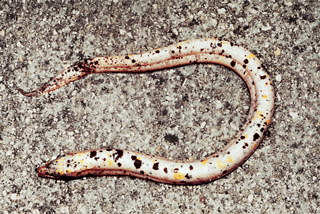 |
| The Asian swamp eel, Monopterus albus, continues to spread. |
In addition to fish, other exotic species are of great concern in Florida. At least 25 percent of all plant species in the State are exotic (Langeland, 1998). Melaleuca, a wetland tree, covers almost 400,000 acres in the State and is particularly troublesome in the Water Conservation Areas (Laroche, 1994). Brazilian pepper, a wetland shrub, has infested more than 100,000 acres in the ENP (Ferriter, 1997). Hydrilla, water hyacinth, water milfoil, and water lettuce are the most abundant exotic aquatic plant species infesting canals throughout southern Florida. Efforts to control or eradicate exotic plant species involve the use of mechanical, chemical, and biological control methods. Numerous herbicides are applied, including 2,4-D, copper sulfate, diquat, endothall, fluridone, glyphosate, imazapyr, triclopyr, and others. At least two of these compounds (2,4-D and triclopyr) have been detected in surface water at the SOFL sites.
| Table of Contents || Previous Section || Next Section || Glossary U.S. Geological Survey Circular 1207 Suggested citation:
|





